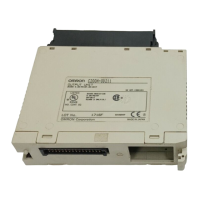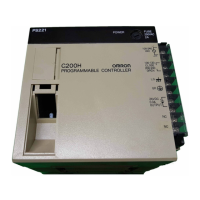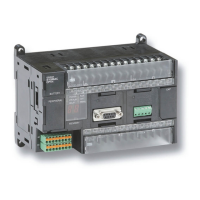71
The following table shows the upper and lower limits that need to be set in
DM 32 through DM 63. In this table, “S” denotes the present value of counter
47 and R is the results word.
DM 32 DM 33 Value of DM 32 ≤ S ≤ value of DM 33 00
DM 34 DM 35 Value of DM 34
≤ S ≤ value of DM 35 01
DM 36 DM 37 Value of DM 36
≤ S ≤ value of DM 37 02
DM 38 DM 39 Value of DM 38
≤ S ≤ value of DM 39 03
DM 40 DM 41 Value of DM 40
≤ S ≤ value of DM 41 04
DM 42 DM 43 Value of DM 42
≤ S ≤ value of DM 43 05
DM 44 DM 45 Value of DM 44
≤ S ≤ value of DM 45 06
DM 46 DM 47 Value of DM 46
≤ S ≤ value of DM 47 07
DM 48 DM 49 Value of DM 48
≤ S ≤ value of DM 49 08
DM 50 DM 51 Value of DM 50
≤ S ≤ value of DM 51 09
DM 52 DM 53 Value of DM 52
≤ S ≤ value of DM 53 10
DM 54 DM 55 Value of DM 54
≤ S ≤ value of DM 55 11
DM 56 DM 57 Value of DM 56
≤ S ≤ value of DM 57 12
DM 58 DM 59 Value of DM 58
≤ S ≤ value of DM 59 13
DM 60 DM 61 Value of DM 60
≤ S ≤ value of DM 61 14
DM 62 DM 63 Value of DM 62
≤ S ≤ value of DM 63 15
Lower
limit
Upper
limit
Present value of the counter Bit of R
that turns
ON
The values must be four-digit BCD in the range 0000 to 9999. Note that fail-
ure to enter BCD values will not activate the ERR Flag. Always set a lower
limit which is less than the corresponding upper limit. MOV is useful in setting
limits. The following ladder diagram shows the use of MOV for setting limits
and the associated timing diagram shows the state of the relevant bits of the
result word (IR 05) as the counter is incremented.
Upper and Lower Limit
Setting
Timer and Counter Instructions Section 5–11

